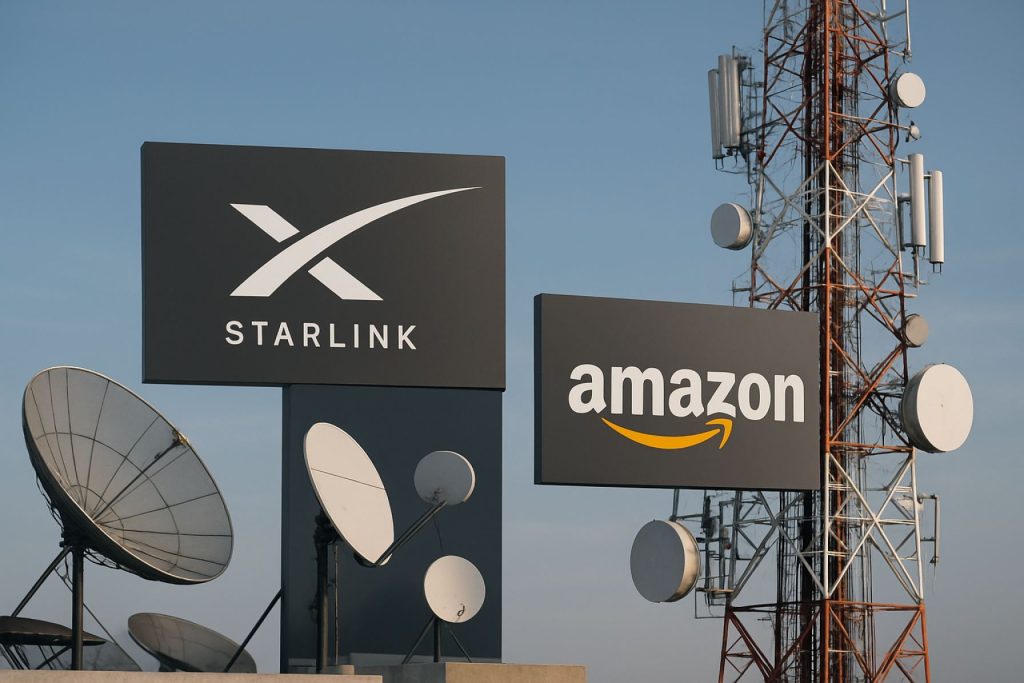
Inside India’s Space Race: Jio, Airtel Face Starlink and Amazon in Explosive Spectrum Battle
As Starlink and Amazon eye India, domestic telcos raise alarms over satcom spectrum rules, calling for a fairer playing field in 2025.
- 17,928M GB: Starlink’s planned India capacity—exceeding all local telcos combined
- 4% SUC: Satcom spectrum usage charge recommended by TRAI
- $5.82: Proposed annual charge per urban satcom subscriber
- 5 Years: Duration for spectrum allocation under new guidelines
India’s telecommunications battlefield is heating up. Global giants Elon Musk’s Starlink and Amazon’s Project Kuiper are racing to launch satellite internet—in direct competition with Reliance Jio, Bharti Airtel, and Vodafone Idea. But as satellite technology promises to reshape connectivity, these local telcos are warning of a potential shakeup that could tilt the landscape for years.
The Cellular Operators Association of India (COAI) is raising red flags over recent recommendations by the Telecom Regulatory Authority of India (TRAI) on how precious satcom spectrum gets allocated. According to a powerful letter sent to India’s Department of Telecommunications (DoT), the telcos claim the new rules give international satellite providers a leg up—potentially leaving domestic providers in the dust.
TRAI, unfazed, has dismissed calls for a policy review—even as a tidal wave of satellite internet capacity approaches. Starlink, now eyeing regulatory clearance, plans to unleash a whopping 17,928 million gigabytes of bandwidth in India. That’s more than the combined muscle of Jio, Airtel, and Vodafone Idea.
Q: Why Are Telcos Crying Foul Over Satellite Spectrum?
Indian telecom giants say TRAI’s recommendations would give NGSO (non-geostationary satellite) operators like Starlink and Amazon a competitive edge—without requiring them to pay the same kind of fees or face similar spectrum auction hurdles as terrestrial players. The telcos argue this is anything but a “level playing field.”
They point out that satcom players could use the newly accessible spectrum to offer broadband services that substitute for both mobile and fixed-line offerings. With administrative allocation and minimal upfront payments (just 4% adjusted gross revenue or $40.78 per MHz, whichever is higher), they fear an uneven competition.
Meanwhile, the COAI has also lambasted plans to use the Digital Bharat Nidhi (DBN) fund—which telcos themselves fund—to subsidize hardware for satellite internet in rural areas. The irony? Telcos potentially bankroll their rivals’ rural rollout.
How Will This Satcom Tug-of-War Impact Indian Consumers?
If TRAI’s recommendations move forward unchanged, Indian consumers might soon have more choices for high-speed internet—even in previously unreachable villages. Starlink and Amazon’s Project Kuiper promise to connect the last mile with cutting-edge satellites that bypass the need for ground-based towers.
But there’s a twist. The “regulatory advantage” for new satcom players could force Indian telcos to rethink investments, slow network upgrades, or spark legal battles. If competition becomes unbalanced, long-standing players warn of market destabilization—a risk for both urban and rural users.
How Could India Strike a Balance in 2025?
As India readies for its digital leap, the government sits at a crossroads. Do policymakers favor speedy rural broadband—no matter the provider? Or do they safeguard the business ecosystem home-grown telcos have built for decades? The answer will shape India’s internet economy and its relationship with pioneers like Starlink and Amazon.
Experts suggest global benchmarking and data-driven analysis—not just assumptions—are critical before finalizing rules. Many call for a transparent review process involving all stakeholders and an SUC regime backed by economic justification.
What’s Next for India’s Satellite Internet Revolution?
With government decisions looming and international launches imminent, India’s telecom future hangs in the balance. Upcoming moves by DoT, paired with legal responses from both local and global players, could set the stage for either a robust, competitive market—or a damaging divide.
Stay tuned as India’s digital future unfolds—whether you’re a consumer, policymaker, or industry insider, your attention (and your internet connection) is at stake!
- ✔ Review latest updates from DoT and TRAI
- ✔ Watch for new launches by Starlink and Project Kuiper
- ✔ Compare broadband offerings—satcom vs. terrestrial—where you live
- ✔ Voice your priorities: affordability, innovation, or industry stability?



